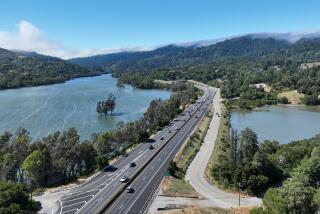Semi Conscious
- Share via
With large truck traffic expected to boom on area roads in the next 20 years, learning to coexist with big rigs is becoming more and more important. But federal highway officials say surprisingly few motorists know even the basics of driving near trucks.
California, one of 34 states with guidelines for sharing the road with big rigs in its driver’s handbook, introduced the chapter about five years ago at the urging of the trucking industry.
Also, the Federal Highway Administration is pushing a public education program called the “No Zone” to warn drivers about truckers’ substantial blind spots. National statistics show about 35% of all truck accidents--more than 90,000 crashes each year--involve situations in which a car was driving in one of a truck’s blind spots. The program has a $500,000 yearly budget and relies on partnerships with private companies to get the word out.
“If you’re in a car, whether it’s a sport-utility vehicle or a compact car, it’s like being a gnat,” said David Longo, spokesman for the Federal Highway Administration. “When you’re up against an 80,000-pound truck, you’re going to lose in any confrontation.”
Tips for driving near trucks:
* Keep in mind that while truckers are higher off the ground, they do not always have a clearer view of the road. Truck drivers have blind spots much larger than those of cars, with areas alongside both sides, the back and front of the truck virtual black holes.
* Don’t linger alongside trucks. If you have to pass a truck, do it quickly and then get clear. Gusts of wind powerful enough to push a car off the road sometimes blow through the undercarriage of a truck’s trailer.
* Never ride closely behind a truck; the trucker will have no idea you are there. If you can’t see the driver in his side mirror, he can’t see you.
* Remember that trucks take much longer to stop than cars. Cars darting in front of big rigs and then slowing down frequently cause accidents. It takes a big rig traveling at 55 mph more than 400 feet to stop. Cars can brake in about half that distance.
* Never try to beat a truck to a single-lane stretch, whether in a construction zone or on a freeway ramp. Trucks take longer to maneuver, and cutting them off removes their safety cushion.
* Always wait for a truck to turn. Trucks frequently make wide right turns, having to move to the left before cutting back to the right. Motorists who misjudge the truck’s intention and try to pass on the right can be run over.
* Never underestimate a truck’s speed or distance. At intersections, large trucks can appear to be going slower than they actually are.
(BEGIN TEXT OF INFOBOX / INFOGRAPHIC)
Sharing the Road With Big Rigs
In 20 years, the segment of I-5 where it meets I-10 is expected to have the busiest truck traffic in the Southland, with nearly 96,000 big rigs traveling along it per day, according to the Southern California Assn. of Governments (SCAG). The agency is in the midst of an 18-month study of trucks-only, truck/carpool and double-deck truck/ car lanes and whether they can alleviate traffic and pollution.
Southland Truck Accidents
Orange County’s rate of truck accidents is less than half the rate of Alameda County, the Southland leader.
(please see microfilm for full graphic information)
More to Read
Sign up for Essential California
The most important California stories and recommendations in your inbox every morning.
You may occasionally receive promotional content from the Los Angeles Times.














